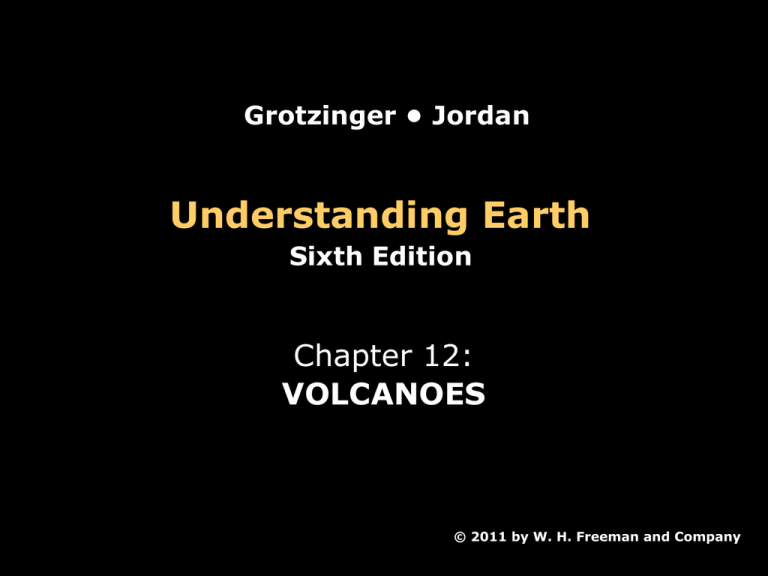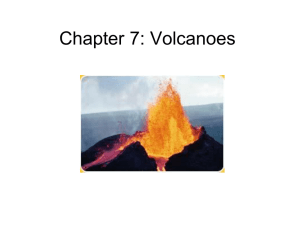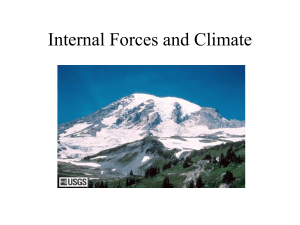Chapter 12 - Volcanoes
advertisement

Grotzinger • Jordan Understanding Earth Sixth Edition Chapter 12: VOLCANOES © 2011 by W. H. Freeman and Company Chapter 12 Volcanoes About Volcanoes • Volcanoes are windows through which we can see the interior of the Earth. • Volcanoes help us understand the plate tectonic process and mantle convection. • Volcanoes are also connected to Earth’s atmosphere and hydrosphere. Lecture Outline 1. Volcanoes as geosystems 2. Lavas and other volcanic deposits 3. Eruptive styles and landforms 4. Interactions of volcanoes with other geosystems 5. The global pattern of volcanism Lecture Outline 6. Volcanism and human affairs 1. Volcanoes as Geosystems ● Parts of the volcano ● hill or mountain made of: ● lavas ● other erupted materials 1. Volcanoes as Geosystems ● Parts of the geosystem ● rocks ● magmas and lavas ● processes of melting and eruption Pipe Central vent Lava flows Side vent Magma chamber Lithosphere Volcanic geosystem Pipe Central vent Volcanic geosystem Lava flows Side vent Magma chamber Lithosphere Magma, which originates in the asthenosphere... Pipe Central vent Lava flows Side vent Magma chamber Lithosphere Volcanic geosystem ...rises through the lithosphere to form a crustal magma chamber. Magma, which originates in the asthenosphere... Pipe Central vent Volcanic geosystem Lava flows Side vent Lavas erupt through a central vent and side vents,... Magma chamber Lithosphere ...rises through the lithosphere to form a crustal magma chamber. Magma, which originates in the asthenosphere... Pipe Central vent Lava flows Side vent Volcanic geosystem ...accumulating on the surface to form a volcano. Lavas erupt through a central vent and side vents,... Magma chamber Lithosphere ...rises through the lithosphere to form a crustal magma chamber. Magma, which originates in the asthenosphere... 1. Volcanoes as Geosystems ● Functions of the geosystem ● volcanic plumbing systems ● volcanoes as chemical factories Thought questions for this chapter Give a few examples of what geologists have learned about Earth’s interior by studying volcanoes and volcanic rocks. 2. Lavas and Other Volcanic Deposits ● Types of lava ● basaltic lavas (10001200ºC) ● aa ● pahoehoe ● pillow lavas Pillow lavas on the sea floor 2. Lavas and Other Volcanic Deposits ● Types of lava (continued) ● andesitic lavas (<1000ºC) ● rhyolitic lavas (600800ºC) Mt. St. Helens’ andesitic cone 2. Lavas and Other Volcanic Deposits ● Texture of volcanic rocks ● reflect conditions under which they crystallized or formed ● vesicles (bubble holes) ● glassy texture (no crystals) ● pyroclasts (broken pieces) Vesicles in basalt 2. Lavas and Other Volcanic Deposits ● Texture of volcanic rocks ● pyroclastic deposits ● volcanic ejecta (ash, bombs) ● pyroclastic flows (volcanic tuffs and breccias) Arenal, Costa Rica: pyroclastic eruption Volcanic ejecta bomb Volcanic tuff Volcanic breccia Mt. Uzen, Japan: pyroclastic ash flow 2. Lavas and Other Volcanic Deposits ● Eruptive styles and landforms ● central eruptions ● shield volcanoes ● volcanic domes ● cinder cones ● stratovolcanoes ● volcanic craters ● calderas ● diatremes Eruptive styles Eruptive styles Crater Lake, Oregon Ship Rock, New Mexico Diatreme Diatreme (Ship Rock) 2. Lavas and Other Volcanic Deposits ● Eruptive styles and landforms ● eruptions from linear cracks ● fissure eruptions ● flood basalts ● ash-flow deposits Fissure eruption: Laki fissure, Iceland Sequence of events: formation of a fissure eruption Flood basalts: Columbia Plateau, Washington Thought questions for this chapter Why are eruptions of stratovolcanoes generally more explosive than those of shield volcanoes? While on a field trip, you come across a volcanic formation that resembles a field of sandbags. The individual ellipsoid forms have a smooth, glassy surface texture. What type of lava is this, and what information does this give you about its history? 3. Interactions of Volcanoes with Other Geosystems ● Volcanism and the hydrosphere ● fumaroles and geysers ● Volcanism and the atmosphere ● aerosols and ash Fumarole: Merapi volcano, Indonesia Old Faithful geyser: Yellowstone National Park 4. Global Pattern of Volcanism 4. Global Pattern of Volcanism ● Basalt-producing spreading centers ● mantle source for lava (decompression melting) ● axial volcanoes of mid-ocean ridge 4. Global Pattern of Volcanism 4. Global Pattern of Volcanism ● Volcanism in subduction zones ● chains of volcanoes ● island arcs ● formation of new continental crust 4. Global Pattern of Volcanism ● Intraplate volcanism: the mantle plume hypothesis ● hot spots and mantle plumes ● sea mounts and island chains ● large igneous provinces 4. Global Pattern of Volcanism 4. Global Pattern of Volcanism: Hawaiian Island Chain / Emperor Seamounts 4. Global Pattern of Volcanism: Yellowstone Volcanic Tracks 4. Global Pattern of Volcanism: Large Igneous Provinces 4. Global Pattern of Volcanism: Large Igneous Provinces Thought questions for this chapter Why are the volcanoes on the northwest side of the Hawaiian Islands dormant whereas those on the southeast side are more active? 5. Volcanism and Human Affairs ● Volcanic hazards ● lahars ● flank collapse ● caldera collapse ● eruption clouds 5. Volcanism and Human Affairs ● Mantle-plume hypothesis ● predicting eruptions ● controlling eruptions 5. Volcanism and Human Affairs ● Natural resources ● volcanic soils ● industrial materials ● ore formation ● heat energy 5. Volcanism and Human Affairs 5. Volcanism and Human Affairs: Potentially Hazardous Volcanoes 5. Volcanism and Human Affairs: Geothermal Energy Thought questions for this chapter What might be the effects on civilization of a Yellowstonetype caldera eruption, such as the one described at the beginning of this chapter? How do interactions between volcanic geosystems and the climate system increase volcanic hazards? Key terms and concepts Andesitic lava Ash-flow deposit Basaltic lava Caldera Crater Diatreme Fissure eruption Flood basalt Geothermal energy Hot spot Hydrothermal activity Lahar Large igneous province Mantle plume Pyroclastic flow Key terms and concepts Rhyolitic lava Shield volcano Stratovolcano Tuff Volcanic geosystem Volcano






